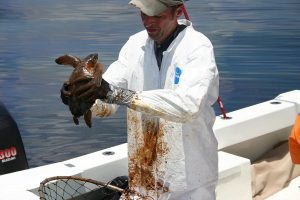The Mess Left by the Gulf Oil Spill
By Jessica Wingar, RJD Intern
Oil spills are notoriously awful environmental events. The worst one to ever occur was on April 2, 2010 in the Gulf of Mexico. One of the Deepwater Horizon oil rigs exploded, killing eleven people, and causing copious gallons of oil to pour into the ocean. After eighty seven days, the rig was capped off, but the damage was already done. The environmental consequences of this spill are very wide ranging. The estimated amount of oil that spilled into the ocean is about 4.9 million barrels and that is probably a low estimate. With this amount of oil and because of ocean currents, this oil spread all around the Gulf of Mexico and into the entire water column. Of course, the animals living in this oil were and still are greatly affected by this spill, and future generations will continue to be effected. From stranded dolphins to oil covered turtles, the list goes on (Gulf Oil Spill).
In addition, to the visible effects, there are many effects of the oil spill that occurred under the surface. Oil contains petroleum hydrocarbons, which are pollutants meaning that they are harmful to organisms that ingest them. These hydrocarbons can lead to the suppression of the immune system, which increases the likelihood of disease in populations. Therefore, increasing the likelihood of death in these organisms, and thus decreasing the populations of many organisms. The effects of these hydrocarbons also lead to a decrease in ability to respond to large changes in environmental factors (Whitehead, A, 2014). However, there are more than just the effects on the present populations of marine organisms. There are many consequences of the spill that will be felt for generations to come.
The effects of oil on the development of fish are of high concern. It is of high concern because the oil from the rig has gone throughout the water column and to the surface. Many fish embryos develop in the surface water. Before the spill, the effect of a lot of crude oil was not an issue, but after this huge spill the worry of developmental problems has increased (Incardona, J.P., 2014).
Many studies have been done since the spill that observe the changes in fish development. One study conducted shortly after the spill looked at developing killifish embryos and adult organisms in order to see how they reacted to the oil. These fish were taken from marshy areas that had been directly affected by the fallout of the deepwater horizon spill. PCB is one of the main toxins in crude oil and these embryos exhibited activation of PCB responsive genes. Therefore, leading to decreased hatching, development, and survival of killifish. These effects are major concerns because killifish are the most abundant vertebrates in the Gulf of Mexico marshy environments (Whitehead, A. et al, 2012). In a study done using oil taken from the slick, amberjack, Bluefin tuna, and yellowfin tuna were raised in a lab and their heart development was observed. As the concentration of oil increased, heart rate decreased and arrhythmia was also observed. In addition to the problems in heart development, there were also physical developmental problems. Fins appeared to be reduced in size and there was decreased development of finfolds (Incardona, J.P., 2014). Another study observing mahi-mahi also showed an increase in heart rate as percentage of oil increased. These important pelagic species also had swimming challenges as they grew.
This same study looked at how the swim speed of mahi-mahi was affected by the Deepwater Horizon oil spill. The mahi were exposed to oil as embryos for 24 and 48 hour periods. Both time exposures showed that when these fish grew to juveniles they experienced a decrease in swim speed that they could maintain for long periods of time. Since it took about 25 days for these decreases to be seen, this study also found that there must be some delay in development as well caused by the polycyclic aromatic hydrocarbons, toxins, in the crude oil from the Deepwater Horizon Spill (Mager, E, 2014). Research is still continuing in order to find out more of the long term effects of this devastating oil spill. This research is increasingly important seeing as in years to come, these effects could be more pronounced in the ocean. In addition, if this research is done, then further work can be done to conserve the organisms that currently live in the Gulf of Mexico.
References
Gulf Oil Spill. (n.d.). Retrieved October 27, 2014, from http://ocean.si.edu/gulf-oil-spill
Incardona, J.P., Gardner, L.D., Linbo, T.L., Brown, T.L., Esbaugh, A.J., Mager, E.M., Stieglitz, J.D., French, B.L., Labenia, J.S., Laetz, C.A., Tagal, M, Sloan, C.A., Elizur, A, Benetti, D.D., Grosell, M, Block, B.A., and Nathaniel L. Scholz. (2014). Deepwater Horizon crude oil impacts the developing hearts of large predatory pelagic fish. Proceedings of the National Academy of Sciences, 111(15): 7053-7061.
Mager, E.M., Esbaugh, A.J., Stieglitz, J.D., Hoenig, R, Bodinier, C, Incardona, J.P., Scholz, N.L., Benetti, D.D., and Martin Grosell. (2014). Acute Embryonic or Juvenile Exposure to Deepwater Horizon Crude Oil Impairs the Swimming Performance of Mahi-Mahi (Coryphaena hippurus). Environmental Science and Technology, 48(12): 7053-7061.
Whitehead, A. (2013). Interactions between Oil-Spill Pollutants and Natural Stressors Can Compound Ecotoxicological Effects. Integrative and Comparative Biology, 53 (4): 635-647.
Whitehead, A, Dubansky, B, Bodinier, C, Garcia, T.I., Miles, S, Pilley, C, Raghunathan, V, Roach, J.L., Walker, N, Walter, R.B., Rice, C.D., and Fernando Galvez. (2012). Genomic and physiological footprint of the Deepwater Horizon oil spill on resident marsh fishes. Proceedings of the National Academy of Sciences, 109 (50): 20298-20302.


